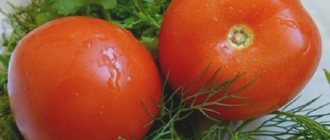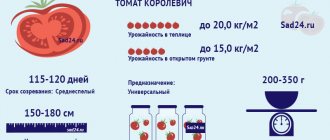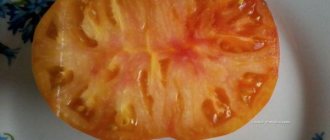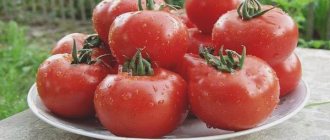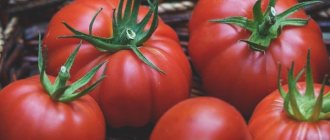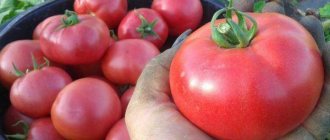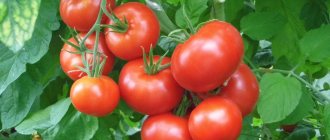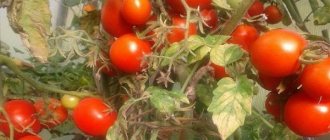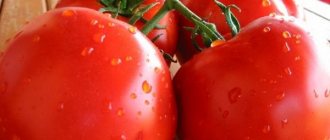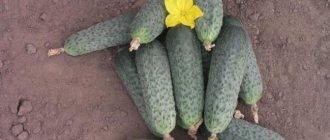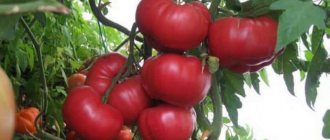Description of the Ural f1 tomato and rules for growing a hybrid variety
Many summer residents are interested in how to grow the Ural F1 tomato, a description of the variety and reviews about it. For the Ural climate and weather conditions, scientists in 2007 created a hybrid variety of tomatoes, which was called the Ural tomato. The breeders tried to make the fruits of the new variety look beautiful and the bushes to produce a rich harvest.
Characteristics of the variety
Reviews from gardeners about Ural F1 tomatoes indicate that the variety’s yield is excellent, the plants are unpretentious, hardy, and are excellent for growing in any region of the country.
On sale you can find two names for this tomato variety: Ural Super and Ural F1. These are the same type of seeds, only advertisers, in order to attract the attention of buyers, began to put 25 seeds in a bag, and not 10, as is customary. Hence, consumers gave tomatoes a second name, which is quite justified, given the excellent characteristics of the variety.
Characteristics and description of the variety:
- Ural F1 was created for growing in a greenhouse, but it can also be planted in open ground. But in greenhouse conditions, the bushes bear fruit better, and the fruits are larger.
- The very first tomatoes on bunches weigh up to 370 g. There can be 2-3 such tomatoes on one bunch.
- The weight of new fruits decreases to 200 g.
- Tomatoes grow very large, which is an exception in the group of hybrid varieties.
- Tomatoes from the Urals have a round-flat shape.
- The surface of the fruit is smooth, with slight ribbing on top.
- The skin is dense and glossy.
- The taste is excellent; from Ural tomatoes you can make tomato juice, paste, various salads, and eat them fresh.
- Tomatoes have a pleasant red color both outside and inside.
The description of the Ural F1 variety proves that tomatoes are excellent for growing commercially. The fruits are transportable over long distances and are perfectly stored in boxes. The skin does not crack during ripening and during transportation. The variety is resistant to diseases.
Other characteristics include:
- A large number of leaves.
- Fruiting throughout the season.
- The bush grows very dense, so it is necessary to remove excess clusters in time so that they do not take away the strength of the fruits that are ripening.
- Summer residents recommend thinning out the deciduous mass from time to time.
- The trunk develops powerful, despite this the plant requires garter to the supports.
- If the season in the greenhouse is long, then one bush is capable of laying 7-10 bunches of fruit.
- The tomatoes ripen evenly and have the same size and shape on the trusses.
- The Ural variety is mid-season, which is due to its large fruits. They simply cannot ripen and fill up quickly.
- The first harvest is harvested 115 days after the first seedlings appear.
- Active fruiting begins on the 120-125th day of planting and continues until the end of autumn. If the temperature in the greenhouse is normal, then you can have fresh tomatoes on the table for much longer.
- The yield per 1 m² is 8-9 kg, which is an excellent indicator for salad tomatoes.
Description of the tomato variety Brother 2 f1, cultivation and yield
Every gardener tries to choose high-yielding varieties of vegetable crops for his plot. Tomato Brother 2 f1 meets these requirements. In addition, the variety is endowed with a host of other positive qualities, which have already been appreciated by many farms and vegetable growing enthusiasts.
Characteristics of the variety
Tomato crop Brat 2 is a fairly new variety of Siberian selection, which is intended for cultivation in open ground, film structures and greenhouse conditions. The vegetable crop is characterized by early fruiting and high yield. The period from seed germination to harvesting ripe tomatoes is about 110 days. The yield of the variety, according to recorded data, varies from 16 to 18 kg per 1 sq. m.
The plant itself is a determinate species, medium-sized, 90–100 cm high. The first raceme (inflorescence) is formed above the 5–6 leaf, all subsequent ones after 1–2 leaves. A simple brush produces 5–6 fruits, weighing from 180 to 250 grams.
Description of fruits
The fruits of the Brother 2 tomato are universally used, which are well used in winter preparations and in the preparation of natural juice.
- The color of ripe fruits is intense crimson;
- shape - regularly rounded;
- the skin is thick and cannot be deformed;
- The pulp is dense and of high taste.
The yield of ripe tomatoes is 98%, harvesting is carried out gradually.
Sowing seeds
Seeds for seedlings of the Bratishka variety are sown at the end of March, beginning of April, according to the following scheme:
- Fertile soil is poured into wooden boxes.
- Grooves are made in the ground, 1 cm deep.
- Seeds are placed and filled into each row.
- After slightly compacting the soil, the soil is watered using the drip method.
- The boxes are covered with glass or film and put away in a dark, warm place.
- When most of the seeds have sprouted, the boxes are moved to a bright place.
- The covering material is removed from the container.
- After 3 days, the seedlings are watered for the first time with a solution of calcium and nitrate.
- In the phase of 2–3 true leaves, picking is carried out.
During growth, small seedlings are fed twice a month with sodium and potassium fertilizers in a ratio of 1:2.
At the stage of 55–60 days, the seedlings are transplanted to a permanent place of growth. Further care consists of constructing a support, regular watering, loosening and weeding.
Reviews
“Good day! I would like to leave a review about tomatoes. Tomatoes of the Bratik 2 variety are very tasty and aromatic. During the harvest period, I eat exclusively from them. Tomatoes are good fresh and in hot dishes. I also use them to make tomato juice and paste for the winter. The variety is unpretentious in care and is not affected by diseases. In general, I recommend it to everyone."
Apt Svetlana. Penza region
“I have been involved in fruit and vegetable growing and gardening for a long time, so I always pay attention to new, hybrid varieties. I am familiar with the Brother 2 tomato relatively recently. This variety caught my eye 2 years ago. Based on the characteristics of the fruit, I would rate it 4.4 on a 5-point scale. But in terms of cultivation, the crop is a weak C.”
“Since I have my own garden plot, I plant tomatoes every year. Having gone through all the varieties, I would like to highlight the tomato Brother 2 f1. The result of his harvest was amazing, I collected more than 4 kg from one bush, and this despite the fact that I live in the Krasnoyarsk Territory.”
Features of planting and care
The seedling method of cultivation is often used. Seeds are sown in advance; each vegetable grower calculates the timing independently, depending on the weather conditions of the region. The age of seedlings transplanted to a permanent place should be 60 days.
Techniques for growing seedlings:
- Lighting and temperature. For normal growth of seedlings, light is required at least 14 hours a day. Air temperature 20–22 ⁰С.
- Watering. Drying or waterlogging of the soil is not allowed.
- Feeding. To form a powerful stem and root system, complex fertilizers are used to stimulate growth.
- Dive at phase 2 of the true leaf.
- The seedlings are hardened off 1–2 weeks before transferring to the soil. Take it out into the open air. First for 15–20 minutes, then increase to 8–10 hours.
Place 3 plants per 1m2 on the beds. Summer residents recommend forming a bush with 2–3 stems; the growth point is removed when the bush is 1–1.5 m in height. Water as needed. The water used is warm.
Description of the Moravian Miracle tomato variety, its characteristics and cultivation featuresRead
Mulching and loosening the beds will help retain moisture in the soil longer. Removing weeds will help avoid the development of diseases and attacks by insect pests.
Sowing seeds
Seeds for seedlings of the Bratishka variety are sown at the end of March, beginning of April, according to the following scheme:
- Fertile soil is poured into wooden boxes.
- Grooves are made in the ground, 1 cm deep.
- Seeds are placed and filled into each row.
- After slightly compacting the soil, the soil is watered using the drip method.
- The boxes are covered with glass or film and put away in a dark, warm place.
- When most of the seeds have sprouted, the boxes are moved to a bright place.
- The covering material is removed from the container.
- After 3 days, the seedlings are watered for the first time with a solution of calcium and nitrate.
- In the phase of 2–3 true leaves, picking is carried out.
During growth, small seedlings are fed twice a month with sodium and potassium fertilizers in a ratio of 1:2.
At the stage of 55–60 days, the seedlings are transplanted to a permanent place of growth. Further care consists of constructing a support, regular watering, loosening and weeding.
How to care
Like any plant, Barin potatoes require a number of procedures that help achieve a good harvest. It should be:
- hilling;
- weeding;
- watering;
- feeding with fertilizers.
Despite the fact that many farmers do not consider hilling an important procedure, it is still better to carry it out in order to protect the plants from diseases. It is enough to just hill up the potatoes twice, and the first time this is done when the shoots reach 15 cm in height, and the second time - after 21 days, and then the soil is loosened with a hoe
There are usually no difficulties with weeding, since it is only enough to regularly destroy the weeds so that Barin receives the necessary moisture and air.
Watering is done in such a way that there is no overflow of water. This potato variety tolerates both moisture and drought well, but you shouldn’t overdo it. The formation of a crust on the soil is unacceptable, so in dry and sunny weather it is advisable to water the potatoes twice a day.
Characteristics
The average height of the bush is from 80 to 100 centimeters. It ripens for quite a long time; after sowing, it bears fruit 110 days later. It has a thick and durable stem that requires additional garter. One inflorescence can produce from 5 to 7 fruits.
The tomatoes are bright red, large, slightly flattened on top. The weight of the vegetable is from 250 to 300 grams. After harvesting, the harvest is stored for up to 45 days. It tolerates transportation well both in unripe and ripe form. The yield per square meter is up to 12 kilograms. This is a very good indicator for such a short plant.
Note! Suitable for growing in industrial conditions and in the garden. The fruit has a good pronounced tomato taste
tomato Barberry - description and characteristics of the variety
What is a Brother 2 tomato?
Description and characteristics of the variety:
- Tomato Brother 2 is a universal variety, suitable for both fresh consumption and winter storage.
- It belongs to the early ripening fruits. The harvest ripens in 100-110 days.
- Up to 18 kg of tomatoes ripen per 1 m².
- Bushes of determinant type, the average height of which is 90-120 cm.
- The first inflorescence appears above the 5th or 6th leaf, and the subsequent ones after it, after every 2nd leaf.
- Each inflorescence or cluster bears 5-6 fruits.
- The weight of one tomato is from 180 to 250 g.
- Tomatoes have a bright crimson color. The shape is round.
- The elastic skin protects the fruits from cracking and deformation, so they can be transported over long distances.
- The inside of the tomatoes is fleshy and dense.
Description of the Zlatov hybrid tomato, growing seedlings and caring for the variety
The Zlatova tomato belongs to a group of hybrids that have unusual fruit colors. The berries of this variety are orange in color with yellow hues. The vegetable can be grown in open ground and in greenhouse complexes. When growing Zlatov's tomato in greenhouses, farmers get better yields than when sowing tomatoes in open areas. These tomatoes are used fresh and canned for the winter.
Briefly about the plant and its fruits
The characteristics and description of the variety are as follows:
- The growing season of a tomato is 110 days from sowing seedlings to harvest.
- The height of the bush reaches 130-150 cm. Therefore, a garter to trellises or stakes is required. A large number of side shoots develop on the stem, which forces farmers to constantly remove shoots and tops at the lower levels of the bush. When bred in a greenhouse, the hybrid reaches a height of 170-200 cm.
- To get a high yield, it is recommended to form bushes with 2 stems. From 6 to 7 fruits are formed on the brush.
- The shape of the tomatoes resembles an orange sphere, but when you cut the berry, you can see the reddish flesh.
- The weight of a tomato ranges from 80 to 120 g.
Feedback from farmers. Those who grow the described variety show that from 1 bush you can get up to 2.5 kg of berries in greenhouse conditions. Gardeners note that the plant is immune to most diseases characteristic of nightshade crops.
Zlatov’s yield indicators do not depend on external conditions. The fruits resist mechanical damage well, so they can be transported over any distance.
In Russia, this hybrid grows in open areas in the southern regions. In the vast expanses of the middle zone and in the northern regions of the country, it is recommended to grow tomatoes in greenhouse blocks and hotbeds.
Obtaining hybrid seedlings
Seeds are disinfected with potassium permanganate or hydrogen peroxide before sowing in special soil for tomatoes. If containers previously used for similar purposes are used for propagating seedlings, they are treated with potassium permanganate. This will reduce the risk of seedlings being damaged by fungi.
Planting material is sown in boxes in the last ten days of March. The seeds are buried 10 mm, and the distance between them should be at least 30 mm. The soil should contain up to 40% peat. It is recommended to immediately transfer the sprouts that appear after 10 days to a lighted place.
After planting the seeds, the soil is treated with a weak solution of potassium permanganate. The seedlings are fed with complex mineral mixtures. To prevent rotting of the roots of the seedlings, drainage, for example, pieces of charcoal, is placed at the bottom of the container. The temperature in the room with the sprouts is maintained at +20°C.
When the seedlings are 55-60 days old, they are transferred to permanent soil. Before this operation, the seedlings are hardened off. The soil in the garden bed is prepared by adding 55 g of superphosphate and potassium sulfate, as well as 50 g of ammonium sulfate for each 1 m².
Seedlings are planted at a soil temperature of at least +13…+14°C. To do this, furrows are made in the beds 0.4-0.45 m wide and up to 20 cm deep. Before planting the seedlings, the soil is treated with Baikal or Fitosporin. The seedlings are not watered 2 days before transplanting, but they are moistened abundantly half an hour before placing the plants in the garden bed.
The first watering of the bushes is carried out 10 days after transplanting the seedlings into the beds. Then water them once a week. The hybrid planting pattern is 0.5x0.5 m. The light must fall evenly on all plants, otherwise the yield of the bushes decreases sharply.
Caring for the hybrid before harvest
Throughout the growing season, tomatoes are fed with complex fertilizers 3-4 times. Initially, nitrogen and potassium mixtures are used for this so that the bushes gain maximum green mass. After the start of tomato flowering, it is recommended to use potassium fertilizers, and when the first fruits form, phosphorus and potassium mixtures are recommended.
How to grow tomatoes?
A shallow box filled with soil is ideal for sowing. Grooves 1 cm deep are made in it. It is recommended to use tweezers to place the grains. The seeds are covered with a thin layer of soil and sprayed with water from a spray bottle.
To create a greenhouse effect and speed up the germination process, the box is covered with glass or film. Place the container in a warm place where the temperature is maintained at +25°C.
When seedlings begin to appear above the soil surface, the covering is removed and the container is moved to a bright place (but not under the sun's rays). Approximately 10 days after sowing, the plant is fertilized with a solution of nitrate and calcium. After the formation of 2-3 leaves, picking is carried out.
Every gardener tries to choose high-yielding varieties of vegetable crops for his plot. Tomato Brother 2 f1 meets these requirements. In addition, the variety is endowed with a host of other positive qualities, which have already been appreciated by many farms and vegetable growing enthusiasts.
Tomato “Raspberry Sugar”
In general, we prefer to eat tomatoes fresh. And this “Raspberry Sugar” was very much loved for its watermelon pulp, aroma and wonderful taste. We use this variety in salads and slices, and it’s also very good to simply eat it while walking around the site!
I grow it in Kuban by direct sowing in a greenhouse in March. It begins to bear fruit in July (mid-late) and produces beautiful clusters of 3-5 pieces. The fruits themselves are 130-180 g, smooth and very beautiful. Fruits until frost. It will, of course, take longer to bear fruit in a greenhouse, but we still haven’t bothered with the greenhouse - somehow the greenhouse is not yet associated with Kuban.
Indeterminate with a stated height of 1.5 m, but mine is a little lower, about 1.3 m. A productive and healthy variety. I treated only with onion and mustard infusion against stink bugs, which have been attacking peppers and tomatoes for the second year.
By the way, about growing in a greenhouse: my husband made a greenhouse for me under a translucent polycarbonate canopy on the south side of the house. This is the influence of N.I. Kurdyumov. Indeed, tomatoes protected from atmospheric moisture are almost not affected by fungal diseases. It’s convenient for me to tie them to the frame of the canopy and assemble them conveniently.
Tomato "Raspberry Sugar". abekker
Description of the tomato variety Biathlon F1, its characteristics and cultivation
If a person has a personal plot, then with a high degree of probability one can find several beds with tomatoes there. Tomato Biathlon F1 is a variety that many will like. The culture is unpretentious and even a novice gardener can cope with it.
Description of the variety
The description of the tomato should begin with the fact that this variety belongs to the early hybrids of the first generation. The tomato harvest is harvested 90-102 days after the seedlings are planted in the soil in permanent beds.
The bush is classified as determinate; the height of the stem does not exceed 85 cm. The plant is medium-leaved, with powerful stems. Leaves have a characteristic shape for many tomatoes. As the bush grows, it will have to be tied up and side shoots removed.
The first inflorescence of the Biathlon variety begins to appear above the 7–9 leaves. Subsequent inflorescences are every 2 leaves. The harvest ripens en masse if the summer is warm and sunny.
The tomato hybrid Biathlon F1 is a truss variety suitable for cultivation in closed greenhouses and open ground. It is recommended to plant 7 bushes per 1 m2.
Fruit characteristics
Characteristics of Biathlon F1 fruits:
- The first tomatoes have a rich red hue. The skin and flesh are the same color.
- The maximum weight of a vegetable is 85–105 g.
- Unripe tomatoes have a yellow spot near the stalk; as they ripen, it turns red.
- Tomatoes are round in shape, the skin is not ribbed at the base of the stalk.
- The pulp is fleshy and juicy. It tastes sweet.
- Tomatoes are less suitable for making salads.
- Tomatoes are more suitable for pickling whole.
Before watering, the soil needs to be loosened. It is often impossible to water Biathlon tomatoes, otherwise the fruits will be watery and tasteless.
Description and characteristics of the variety
Tomato Brother f1 is a determinate hybrid, a child of modern selection. Powerful, medium-sized stems firmly hold 7-8 fruiting clusters, each with up to 6 tomatoes.
Ripening 95-110 days after germination. Raspberry-pink colored tomatoes have a wonderful sweetish taste and slight sourness.
The average fruit weight varies from 190 to 250g.
Characteristics and description of the variety, yield
Tomato Crystal is a hybrid from the famous French producer of seed material, Clause, whose varietal samples enjoy a well-deserved good reputation and great millet. Like other hybrids from breeders from France, the variety has many advantages. This is an indeterminate type of tomato, which is distinguished by its tall bush growth, compact, approximately identical fruits weighing from 120 to 160 g. Small three-chambered fruits of a rich red color, with no lettuce or green spots on the peel, and a small number of seeds in the seed cells.
The variety is grown in greenhouses all year round, so it can often be seen on supermarket shelves. Unlike other varietal hybrids, it has a bright, pronounced taste, sweet and slightly sour. This gives it an original aftertaste when eaten fresh.
Fact! It is considered one of the optimal varieties for canning, due to the approximately equal small size of the fruits and the ability to maintain their natural shape, thanks to a 6-8 mm thick wall.
Farmers are willing to grow Crystal because it is resistant to almost all diseases of nightshade fruit trees. The bush, despite its considerable height, grows with stable stems and a large number of tomatoes on the clusters. According to gardeners, 10-12 small fruits grow on the cluster, which are convenient to pick from the bush. They ripen almost simultaneously, easily move away from the stalk, the weight of all tomatoes picked from one bunch is more than one and a half kg.
When growing for commercial profit, you can pick tomatoes from the bush with tassels. This reduces the compactness of installation, but significantly increases the keeping quality. maintaining taste and fresh appearance. The brush is very easily separated from the main stem when mature, and the height of the bush allows you to harvest without additional time and labor costs.
In general, the variety receives favorable reviews from domestic breeders, and is included in the State Register of tomato varieties approved for cultivation in the Central and Central Black Earth regions. The manufacturer advises limiting yourself to 1 stem and removing all side shoots to increase fruiting. Domestic gardeners, especially when growing in greenhouses, prefer double-stem formation and garter using a trellis method.
In the south, Crystal is grown in open ground due to the short period of fruit ripening (65-70 days). On soil without shelter, the bush turns out to be lower, but strong, with a dense and strong stem, dark green foliage and requires constant pinching.
Important! Despite the restrictions of the State Register, the Crystal tomato grows well in different weather conditions and areas with problematic climates, and in a greenhouse it produces a consistently high yield. Repeatedly included in ratings of the best early varieties for cultivation in greenhouse conditions. The variety is intended for universal use, suitable for fresh eating, heat treatment and canning.
The variety is intended for universal use, suitable for fresh eating, heat treatment and canning.
Description
Mid-season indeterminate variety. From the moment the sprouts appear until harvest, 111–115 days pass. Plant height is 1.5–1.8 m. Due to this growth, the bushes need shaping and pinching.
Inflorescences of the intermediate type are planted above the 10th leaf and are repeated every 3 subsequent ones. The medium-sized leaves are green. The fruits are round, slightly flattened. Tomatoes at technical ripeness are green with a dark spot, and when they reach biological ripeness they are pink-red. The pulp is tasty, tender, sweet. Fruit weight - 200–250 g.
Tomatoes are used to make salads and tomato juices. Thanks to the mild taste of the vegetable, children really like preparations made from it. With proper care, the yield is 12–15 kg per 1 sq. meters, in closed ground the yield can reach 15.6 kg. The Boyarynya variety is grown in garden beds and indoors.
The advantages of tomatoes of hybrid origin include:
- high productivity;
- extended fruiting;
- marketable condition;
- good taste;
Tomato "Yablonka Rossii" - an early ripening variety for open ground
“Apple Tree of Russia” is only slightly inferior in popularity to the “Sanka” variety. To some extent, these are competing varieties - both were created for open ground, both are early ripening and both give a good harvest for open ground. True, in my opinion, “Sanka” tastes better. However, first things first.
The tomato variety “Yablonka Rossii” was bred by it is not entirely clear who. The list of authors includes the name of Vladislav Korochkin, the president of the group, but it is unlikely that he himself was involved in selection work. Viktor Anatolyevich Vasilevsky from the All-Russian Research Institute of Selection and Seed Production of Vegetable Crops and other specialists are also mentioned among the co-authors. The originator of the variety is NK LTD, which is directly related to the Russian Vegetable Garden.
The variety was registered in the Register in 2000. It also went on sale around the same time.
In the 90s, the Tamina tomato variety, which was quite similar in appearance to YAR, was quite popular. Sometimes both names are indicated on seed packets. In the Register, however, the Tamina tomato variety is not mentioned anywhere.
Characteristics
| Type | determinant |
| Plant height | about 100 cm |
| Fruit | Round, smooth, weighing up to 80 grams, red |
| Taste | good |
| Ripening period | early, about 90 days |
| Disease resistance | no convincing data |
Description
“Yablonka Rossii” is a determinate, medium-growing variety. The height of the bush is usually about a meter or a little more, but in greenhouses some amateur gardeners have it. This is a standard tomato: “Apple tree” forms a fairly compact bush with a thick stem and medium-sized “potato” leaves. The tomato, of course, needs to be tied up, but it’s quite late.
The first inflorescence is laid over 7-9 leaves, the subsequent ones - after 2 leaves. Inflorescences can be simple or intermediate (with one branch), the stalk with an articulation.
Tomatoes “Yablonka Rossii” are round, with a smooth surface, weighing up to 80 grams. Unripe tomatoes are light green, ripe ones are deep red. Nest with seeds. The taste is good. Recommended for use for whole-fruit canning, but also suitable for salads and for processing into pastes.
Features of cultivation
The “Yablonka Rossii” tomato is approved for cultivation in all regions of the Russian Federation as a variety for open ground. I grew it in 2015 and plan to grow it in 2021. It is a fairly unpretentious and stable variety.
The 60 x 50 planting scheme worked well. I fully formed some plants into three stems, and some I didn’t plant at all. There were only a few specimens in each group: therefore, unambiguous conclusions cannot be drawn, but in general, the non-stepchildren seemed to me more productive. By the end of August, absolutely all the tomatoes had time to ripen, but August 2015 was very hot.
The variety is early ripening - ripening begins approximately 90 days after emergence, even in open ground. Probably, in a greenhouse you can get a harvest even earlier.
The register states that the variety is characterized by uniform ripening of fruits, but for me the fruiting and ripening were rather extended. Productivity according to the register is 5.3...5.6 kg/m2. I didn’t document the yield on my bushes, but I feel like each plant produced at least 2 kg of marketable tomatoes. In terms of per square meter this will give more than 6 kg.
Advantages
- possibility of growing in open ground;
- ease of cultivation;
- early ripening;
- uniformity of tomatoes in size;
- relatively high yield.
Tomato Fancy characteristics and description of the variety, cultivation and opinion of gardeners with photos
Fenda tomato growing technology
The height of the bushes reaches 2 meters; in greenhouses, growth is unlimited. The growing season of the variety is 70-80 days. The main stem is straight and strong, the leaf blade is quite large, and the rhizome is well developed.
6-10 ovaries are formed on one bunch. A ripe tomato weighs from 250 g to 400 g, the shape of the tomato is round with a pink color. The increased sugar content gives the fruit a sweet taste with a slight sourness. Inside the dense vegetable there are 6 chambers containing seeds. The pulp is fleshy and juicy.
One plant can have 40-50 fruits. Up to 25 kg of tomatoes are harvested from one square. Thanks to its early ripening period, the Fenda variety can be grown twice per season: from spring to summer, from summer to autumn.
- tomatoes are transportable;
- the skin is dense, the fruits do not crack;
- bushes can be grown under film or without it;
- excellent taste and attractive appearance;
- The variety is resistant to many diseases.
- tall bushes require constant garters;
- The variety is demanding on fertilizing.
The indeterminate hybrid prefers greenhouse conditions. It is better to germinate seedlings yourself in early spring. Seeds should be purchased from trusted suppliers, and do not forget to look at the expiration dates on the label. Small and damaged seeds are removed, the rest are dipped in a light manganese solution for 20 minutes, washed and slightly dried.
The seeds are sown in prepared containers, covered with a layer of soil on top and watered. After the sprouts appear (7-10 days), the temperature in the room is reduced to 15 degrees, this is done so that the plant can independently synthesize organic substances from inorganic ones, and also does not grow rapidly.
After a week, the temperature gradually begins to increase until it reaches 22-24 degrees. The container needs to be moved to a lighted place; if there is not enough light, connect daylight lamps. The soil should be moistened 1-2 times every 7 days.
The plants are picked into a separate container when the first leaves appear on the mature seedlings. At the time of transplanting into the garden, the plants reach 25-30 cm in height and have approximately 6-9 leaves. Ovaries are formed every 5 leaves.
A few days before planting seedlings, the soil in the garden should be dug up to a depth of 12-14 cm. Complex fertilizers (NPK-15-20 kg/ha) are applied to the soil. Seedlings are planted in holes in rows according to a pattern of 50 cm by 40 cm, 3-4 bushes are placed per square meter.
Every 4-5 days, moderate watering is done (500 ml of water per plant), water the bushes at the root in the morning until the seedlings take root, the soil moisture should be 80% NV.
Feeding
A rich tomato harvest is achieved with timely feeding. Potassium supplements synthesize vitamin C, increase root growth, and store carbohydrates. Potassium is added during seedling growth, then from the beginning of ovary formation and during fruit ripening.
Phosphorus supplements (superphosphate, precipitate) are necessary for the ripening of fruits and seeds; phosphorus is added twice during the growing season.
Nitrogen gives plants their green color. But an overdose of nitrogen supplements can lead to the development of abundant foliage, and the plant will not have any strength left for the fruits. Nitrogen (ammonium sulfate, manure, urea, ammonium nitrate) is added twice during the growing season: the first time - with the main additives during planting of seedlings, the second time - from the beginning of the formation of ovaries. Since nitrogen fertilizers make the soil acidic, limestone must be added.
Garters
We must not forget to weed weeds, remove dry leaves, and spray bushes to prevent diseases and combat pests.
If tomatoes are cared for incorrectly and poorly, especially if the soil moisture is high, diseases may occur:
Sick plants need to be removed and destroyed to avoid infecting neighboring bushes. Mineral supplements increase the immunity of tomatoes and protect the crop from late blight. Insecticides are used to control pests (cutworm, aphids, Colorado potato beetle).
Features of cultivation and storage
Tomatoes are grown in the traditional way - through seedlings.
Seeds are sown in late March - early April.
Prepared fertile soil is poured into containers. The soil is first disinfected with 1% potassium permanganate and calcined in the oven.
Sowing seedlings and care:
- seeds are placed in grooves to a depth of 1.5 cm, distance - 2 cm;
- until germination, cover with film and keep at 24 ° C;
- then the cover is removed and hardened at 15°C;
- dive with 2 true leaves;
- fertilized with mineral fertilizers made from calcium and nitrate.
For storage, use a dark, cool room without dampness or drafts. Duration of storage without loss of properties is up to 2 weeks.
